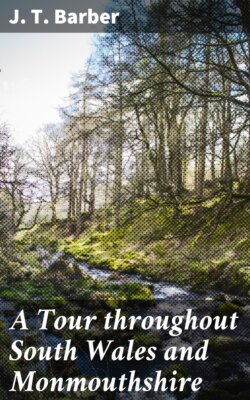Читать книгу A Tour throughout South Wales and Monmouthshire - J. T. Barber - Страница 9
На сайте Литреса книга снята с продажи.
CHAP. II.
ОглавлениеTable of Contents
LOUGHOR—LLANELLY—PEMBREE-HILL—KIDWELLY, AND ITS CASTLE.
Having satisfied ourselves with the peninsula of Gower, we entered upon a zigzag excursion, round the coast of South-Wales, to its northern boundary, purposing to return to Swansea by a midland route. My friend had bought an excellent travelling horse, though aged, and a little foundered, for twelve pounds. I was not so fortunate; the few others that we met with for sale, were miserable poneys, and at a price double their value in London: I was, therefore, constrained to engage a poor little hack, at two guineas for a fortnight’s use; and thus mounted we set forward over a high romantic district to Loughor, the Leucarium of Antoninus, now a poor village; but still exhibiting the ruined keep of its castle, on a raised mount surrounded by a moat. From this place, soiled with the filth of neighbouring collieries, we had a river to ford to the opposite shore. This task is by no means enviable; for, in addition to fording a rapid current over a rough stoney bottom, large hollows are formed by vessels at low water, which, not appearing, sometimes entrap the unsuspecting traveller, who may think himself well off if he escape with only a ducking: we thanked our stars when we got across; and, wading through a miserable road, and a region of collieries, arrived at Llanelly (pronounced Llanithly). About half way between the ford and this town, we observed Capel Ddewy, a small ruin, picturesquely accompanied by a yew-tree; and near it the remains of some deserted furnaces.
In this ride we proceeded at an uncertainty, till we were fortunately assisted by an agreeable matron, who was churning at the door of her cottage. Now, as the noise of her employment prevented our hearing each other, she was obliged to leave off; but, that the interval of a few moments from labour might not pass unproductively, she caught up her knitting needles at the same instant, and advanced the fabric of a stocking while she gave us our directions. Such instances of persevering industry were frequent throughout the principality; but more particularly so from hence westward, where not a female was to be seen unemployed in knitting, however she might be otherwise at work, in carrying loads or driving cattle.
Llanelly is a small irregular town, and contains an old seat of Sir John Stepney’s, which, though deserted by the family, afforded habitation to numerous tenants, till the mischievous operation of the window-tax, in driving them out, left it to moulder in decay. The high square embattled tower of its church is remarkable, in being much wider at the base than upwards, forming a sort of cone. This town, however, offering no objects to detain us, we proceeded without halting, and in a few miles ride gained the summit of Pembree hill.
Here a marine view of great extent burst upon us; the grand sweep of Caermarthen bay appeared beneath, terminated on one side by Wormshead point, and on the other by the insulated rock of Caldy in Pembrokeshire; the opposite shores of Somerset and Devon formed the distance, faintly skirting the horizon beyond a vast expanse of sea, studded with numerous vessels. Looking internally, the country exhibited a strong undulatory surface, variously chequered with wild heaths and rich cultivation. Descending the hill, we approached the neat regular-built town of new Kidwelly, situated in a narrow well-wooded valley.
The castle forms a noble object, adjoining the ruins of old Kidwelly on the opposite bank of the river. Leland says, “the old town is prettily waullid, and hath hard by the waul a Castel; the old town is nearly al desolated but the cartel is meately well kept up.” This description applies very well to the present appearance of the place; for, though the castle is uninhabited, it continues tolerably entire. This fortress was built soon after the Conquest, by Maurice de Londres, one of the twelve Norman knights who conquered Glamorganshire; and, after undergoing the usual vicissitudes of sieges, partial demolition, and different masters, fell to the crown of England. We were disappointed of an internal examination of this fine ruin, as the key of the entrance could not readily be obtained, and we were pressed for time to reach Caermarthen before dark. The continuance of our route led us on a steep woody bank, above the romantic course of Kidwelly river; but it soon deviated to the superior attractions of the Towey; following whose expansive water and verdant accompaniments, and crossing a long antique bridge, we reached Caermarthen.
